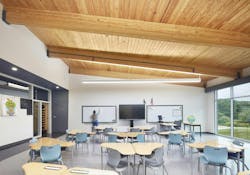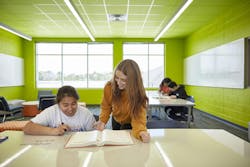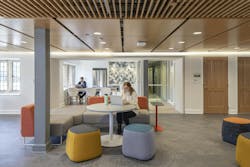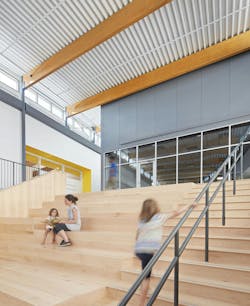The importance of selecting healthy materials for K-12 projects
According to the U.S. Environmental Protection Agency, the average person spends about 90% of their lifetime inside a built environment. As a multi-disciplinary firm, we strive to design environments that positively impact on the health, safety, and welfare of all users, especially our younger clientele in the K-12 market sector.
The chemicals and biological pollutants found indoors contribute to significant health impacts, both short and long-term. Children are the most susceptible user group of pollutants, making it even more imperative to specify healthy building materials in our K-12 schools to combat the potential life-long effects of their home-away-from-home: school.
Why Choose Healthy Building Materials?
There are many motivating reasons for choosing healthy materials within buildings: Increased indoor air quality, reduced irritants, minimizing allergens, and reducing endocrine disruptors. When designing a K-12 building, these all play a vital role in helping positively impact the overall health of students.
Healthy materials can improve students’ attention and focus, which can increase test scores, improve participation, and lower absenteeism. As a result, the ripple effect of choosing the right materials for a building and its occupants can be monumental.
Product Specification
Specifying products with no red list materials, such as phthalates, and zero off-gassing of volatile organic compounds (VOCs) is being proactive in sustainable and healthy design. But if we can take it a step further and select finishes that meet the requirements that establish what is a ‘green’ material, choosing products that are durable and can be recycled at the end of their life spans can help ensure a building lasts for decades rather than years.
In turn, this promotes a circular economy. When the lifespan of a building has expired, the materials within it can be repurposed, reused, and recycled. Suppose we can continue to expand this line of thinking throughout the industry. In that case, we can protect current and future building occupants by specifying products that are ‘green’ and perform just as well, if not better, than their ‘standard’ counterparts.
Beyond Healthy Materials
Take a moment and look at the picture above, of the two students smiling while they read from an open textbook. Ask yourself, what is making them smile? What is beyond the picture that we cannot see? As designers, we must ask ourselves this question as we continue constructing and promoting sustainable designs.
As we specify healthy building materials, we need to be conscious that we can be leaders in educating ourselves, our clients, and our industry partners on how valuable healthy material selection can be. During the selection process, we want to make sure that we are specifying the whole package, including aesthetically pleasing visuals (colors, patterns, textures), auditory (striking a balance between absorptive and reflective surfaces), and maintenance characteristics (durability, cleanability, and the life cycle of a product).
We agree with the Whole Building Design Guide that, “schools should be comfortable visually, acoustically, and thermally; they should have excellent indoor air quality; and they should be safe and secure. These buildings should also be good environmental citizens as they are teaching tools in and of themselves.”
AIA 2030 Challenge
As a firm, choosing to design with healthy materials has become one of our primary goals as we have aligned ourselves with healthy building initiatives such as the AIA 2030 Challenge. The AIA 2030 Challenge targets having all new buildings and renovations be carbon-neutral by 2030.
According to Architecture 2030, “The built environment is responsible for about 42% of annual global carbon emissions.” We can achieve a lower emissions rate by starting within buildings and reducing the embodied carbon of the chosen materials.
The Whole Building Design Guide specifies that embodied carbon is the total energy required to fabricate a finished product, which includes the, “energy used to grow, extract, manufacture, and transport it to the point of use … and the emissions that occur during the manufacture, transport, construction process, and end-of-life aspects of a product and its components.” Selecting materials and manufacturers who are transparent about the ingredients of their products and have sustainability goals creates successful partnerships within the built environment.
Best Places for Healthy Materials
For healthy materials to make an impact, we need to consider the volume and location in which they will be used. Take, for example, high-touch surfaces in schools. These areas include floors, toilet room partitions, gymnasiums, cafeterias, corridors, painted walls, lockers, furniture, and window coverings.
Specifying paint with no VOCs prevents harmful chemicals from being released into the air, which lowers adverse health effects such as irritations, headaches, allergies, and potentially long-term damage to organs and central nervous systems. This is extremely important in the K-12 market sector as, according to the Environmental Protection Agency, “children often experience higher exposures to environmental pollutants than adults because, per pound of body weight, they breathe more air and ingest more material, and absorb more contaminants than adults.”
Best Places: Flooring
Switching from soft flooring (carpet) to resilient hard surfaces (luxury vinyl tile) helps minimize the amount of dust and allergens in classrooms while making them easier to clean and maintain. For example, selecting a floor material such as marmoleum, made of natural raw materials, is climate-positive with its carbon impact, recyclability, and is phthalate-free (red list chemical)
If carpet is desired for acoustics, manufacturers have responded with hybrid flooring alternatives. These advanced textile composite flooring options combine the key attributes of a soft surface floor covering (comfort and acoustics) with the performance characteristics of resilient hard surfaces (durability and ease of maintenance).
Best Places: Lockers and Bathrooms
Another finish within a school that students interact with every single day is their lockers and toilet partitions. Specifying high-density polyethylene (HDPE) lockers is a healthy material that provides health and safety benefits for students: The material resists mold because it is non-porous, is antimicrobial, does not require harsh chemical cleaners, is power/steam washable, and has low-zero VOCs.
Best Places: Furniture
Furniture is another high-touch surface, especially in a K-12 school. The finishes and materials on furniture contribute to an occupant’s health, safety, and welfare just as much as the interior building materials. The coatings added to the finishes and fabrics also play a role in healthy building materials and can contribute to the health impacts of building occupants.
Many finish coatings are harmful to indoor air quality, and manufacturers are rethinking how to protect the longevity of a finish or fabric without harsh chemical coatings. We are constantly educating ourselves on the latest technology and finishes that are PFAS (per- and polyfluorinated substances) free but will still hold up to the constant wear and tear during their lifetime.
The breadth of knowledge of where healthy materials, finishes, and coatings can and should be placed within a building is abundant. Knowing where high-touch surfaces are and installing finishes that directly help minimize negative health impacts for occupants is key.
Vetting Healthy Materials + Third-Party Certifications
It is vital to research and ensure that products, ingredients, and materials labeled as healthy provide the benefits they claim. To do that, we rely heavily on third-party certification systems to keep manufacturers in the industry accountable for their manufacturing processes and product performance.
Product transparency and material ingredient reporting help us and designers throughout the industry select healthy and sustainable building products/finishes that will perform how we need them to and contribute to the longevity of the building.
Below are a few third-party certifications that we look for:
- Greenguard
- Heath Product Declarations (HPDs)
- Declare Labels
- Cradle-To-Cradle Certified
- Living Building Challenge
- Business and Institutional Furniture Manufacturers (BIFMA)
- SCS Indoor Advantage
- USDA Biopreferred – Certified Biobased Product
Healthy building materials can impact building occupants in many ways, so it is essential to think about the past, present, and future of K-12 buildings. Change is inevitable, and in our industry, it can be constant as it strives towards providing, producing, and creating higher quality products that emphasize sustainable and healthy materials.
We must continue to stay diligent and fluent in the changes to remain partners in the mission to design built environments that positively impact the health, safety, and welfare of all its users.




